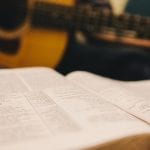It’s all too easy to look up at the end of December and—poof—realize the opportunity for meaningful reflection has passed, vacuumed up or packed away for next year, like another decoration. So this Christmas, how can we truly be present and not just buy presents? We find the answer in the most fundamental (and perhaps surprising) of places—in singing traditional carols together.
Redemption drew a baby breath that first chilly Christmas night, offering hope to a forlorn world dying to be rescued. But even before Jesus lay in the manger, his miraculous story was already being told in song. Mary sang about him in the Magnificat (Luke 1:46–51). Zechariah sang about him in the Benedictus (Luke 1:68–79). And of course, on the night of his birth, the skies over the shepherds’ field became a vertical stage for hosts of choiring angels.
We have each been created, compelled, and commanded to sing. It’s thus no surprise that the oldest Christmas traditions are the masterpieces of the carols. Our sixth annual Christmas event—Sing! An Irish Christmas Tour—features 10 timeless hymns none of us should ever forget.
1. Hark! The Herald Angels Sing was penned by Charles Wesley and included in his 1739 Methodist hymnal. This theologically rich classic was later set to music by Felix Mendelssohn. It began as “Hark, How All the Welkin Rings,” but George Whitefield did us all a favor by changing the words to “Hark! The Herald Angels Sing.” We conclude the first half of our Christmas concert with this song, including an Irish reel and cultural Irish dance, which I suspect would have pleased neither Wesley nor Mendelssohn!
2. Come, Thou Long Expected Jesus appeared in Charles Wesley’s book of 18 Christmas songs in 1745, and it’s one of my three favorite hymns today. The song captures how centuries of waiting, longing, and weeping find ultimate resolution in Christ: “Israel’s strength and consolation / Hope of all the earth thou art / Dear desire of every nation / Joy of every longing heart.”
3. O Come, All Ye Faithful is a Christmas call to worship, mostly likely written by John Francis Wade, a Catholic artist who created beautiful manuscripts decorated with exquisite floral images. His hymn “Adeste Fidelis” remained a Latin masterpiece for 100 years before being translated into English by Frederick Oakeley. For congregational and a cappella purposes, this carol sings beautifully.
4. In the Bleak Midwinter is among our most plaintive carols, partly because of the haunting melody by Gustav Holst. Penned by English poet Christina Rossetti, the lyrics first appeared in 1872. The last stanza says it all: “What can I give him, poor as I am? / If I were a shepherd I would bring him a lamb; / If I were a wise man I would do my part, / Yet what I can I give him? Give my heart.”
5. Joy to the World, with its triumphant cadence and rousing spirit, was written by the man commonly called the “Father of the English Hymn,” Isaac Watts. This hymn was published in 1719 and wasn’t even originally considered a Christmas carol.
6. O Come, O Come Emmanuel is a medieval Latin hymn dating from the 800s. It was one of a series of antiphons sung each December, and it isn’t hard to imagine the mystical beauty of this hymn echoing off the walls of remote monasteries during the Middle Ages. This particular antiphon was discovered by an English minister and musician named John Mason Neale, who rendered it into English and published it in 1851.
7. Joy Has Dawned is a hymn Stuart Townend and I wrote back in 2004. Stuart wanted to draw out parts of the Christmas story, such as the gifts of the magi, that aren’t particularly present in other Christmas hymns. Melodically, we wanted to give this carol the same feel people might expect from the classic Christmas songs they grew up singing in church.
8. Angels We Have Heard On High is one of the most joyful and well-written choruses ever composed. The lyrical journey shines a light on the reality of incarnation in a way that refreshes the soul each time you sing it.
9. O Little Town of Bethlehem was inspired by Philadelphia pastor Phillips Brooks’s visit to Bethlehem. Around 1867, Brooks wrote the lyrics and passed them along to the church’s worship leader, Lewis Redner, who composed the melody. It was first sung by a group of six Sunday school teachers and 36 children.
10. Once in Royal David’s City might be the least known of these 10 carols, but we mustn’t lose its message or music. Cecil Frances Alexander was an Irish pastor’s wife who published this carol for children in 1848. Today, many consider her works too deep to sing in adult congregations. If ever we needed empirical evidence that the Irish actually did save civilization, this may actually be it.
These 10 carols—among many others—are treasures that remind us of the gospel joy we’re to share with the world in the bleak midwinter. They remind us that hope has dawned in the little town of Bethlehem, in royal David’s city, and that we should all join the triumph of the skies.
O come, let us adore him—Christ the Lord!
Is there enough evidence for us to believe the Gospels?
 In an age of faith deconstruction and skepticism about the Bible’s authority, it’s common to hear claims that the Gospels are unreliable propaganda. And if the Gospels are shown to be historically unreliable, the whole foundation of Christianity begins to crumble.
In an age of faith deconstruction and skepticism about the Bible’s authority, it’s common to hear claims that the Gospels are unreliable propaganda. And if the Gospels are shown to be historically unreliable, the whole foundation of Christianity begins to crumble.


































